We just got word from VAEEC Business Platinum member E4TheFuture that there is a letter that companies and organizations can sign on to requesting that Congress continue to support residential energy efficiency, including critical funding for:
- Home Performance with ENERGY STAR
- Home Energy Score
- Weatherization Assistance Program
- State Energy Program
VAEEC has signed the letter and encourages our members to consider doing the same.
The letter opens: “As organizations and businesses that work to advance residential energy efficiency, we are writing in support of at least level funding during the remainder of Fiscal Year (FY) 2017 and in FY2018 for the U.S. Department of Energy (DOE)’s residential programs at the Building Technology Office and Weatherization and Intergovernmental Activities. These programs return benefits and savings to American homeowners, consumers, and businesses many times more than the public’s investment. We urge you to maintain at least the current level of funding and work with the new administration to ensure these programs continue to support increased economic and energy productivity.”
Read the full letter and consider signing your company or organization to send a strong and united voice on support for residential energy efficiency programs.
Deadline to sign on is Friday, March 17.
“Ensuring an energy-efficient home requires a whole concept approach. From attic to basement and everything in between, a variety of potential upgrades and improvements can make for cooler summers, warmer winters and more cash in your wallet all year round. Take advantage of available energy efficiency programs in your area and embark on a “less is more” approach to energy. Saving for a rainy day is one thing, but saving on energy costs well into the future means you’re going to need a larger piggy bank.”
That’s a message from VAEEC Business Platinum member and March Featured Member of the Month Washington Gas to its customers, a message it backs up with rebates, resources and a new Online Home Energy Audit tool.
Who is Washington Gas?
 Washington Gas, a WGL Holdings, Inc. company, delivers natural gas to more than one million residential, commercial and industrial customers throughout Washington, D.C., and the
Washington Gas, a WGL Holdings, Inc. company, delivers natural gas to more than one million residential, commercial and industrial customers throughout Washington, D.C., and the  surrounding region. Washington Gas was founded in 1848, through a Congressional charter signed into law by President James K. Polk. The new company installed gas lights in the House and Senate chambers, the White House and along Pennsylvania Avenue.
surrounding region. Washington Gas was founded in 1848, through a Congressional charter signed into law by President James K. Polk. The new company installed gas lights in the House and Senate chambers, the White House and along Pennsylvania Avenue.
What does Washington Gas offer to Virginia home and business owners?
Space heating is the largest energy consumer in a home, typically accounting for over 40 percent of a home’s energy consumption. It is also an area where significant energy savings can be realized. Currently Washington Gas offers Virginia residents a $300 rebate on a natural gas furnace with 90 percent or greater annual fuel utilization efficiency (AFUE) and a $50 rebate on a Wi-Fi-enabled programmable thermostat.
The website offers easy-to-access residential and commercial rebates. 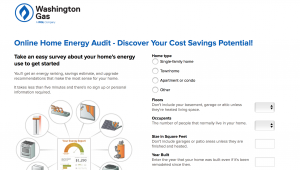
They recently added to their portfolio of customer-friendly tools an Online Home Energy Audit. By answering a few simple questions, you get an energy score , savings estimate and upgrade recommendations that make the most sense for your home. It’s a smart, interactive feature for engaging customers.
Find out more about what Washington Gas is doing on energy efficiency.
Industrial efficiency was the focus of VAEEC’s third webinar in our quarterly series. “Opportunities for Industrial Energy Efficiency in the Commonwealth” provided an opportunity for participants to learn about Combined Heat and Power (CHP) and Waste Heat to Power (WHP) and how it can make Virginia manufacturers more competitive, save money for all ratepayers, and lower the state’s emissions.
Thank you to the webinar sponsor, the Alliance for Industrial Efficiency. 
Download the presentation and recording.
We were honored to have three knowledgeable speakers who were able to share their expertise with attendees:
- Jennifer Kefer, Alliance for Industrial Efficiency
- Dalia El Tawy, Siemens
- Charles Miller, WGL Energy
Over the course of an hour, they were able to provide an overview of CHP/WHP (including their importance, benefits, and scale of opportunity), examples of CHP/WHP being used across the globe, programs and barriers in Virginia, and what more needs to happen to get CHP/WHP in the state.
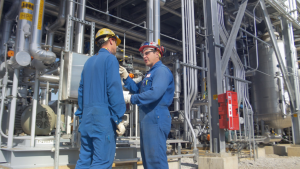 There are currently 4,400 CHP projects installed nationwide, and the majority are used for industrial applications. Manufacturer, public, and utility benefits of CHP include increased productivity and decreased operating costs. Hood Dairy in Winchester, Virginia, provides a good example. Hood worked with ZF Energy Development to design a 15-MW microgrid, which includes CHP. Not only does this give Hood a reliable, efficient source of power and food security, but it has allowed them to achieve a net savings of at least 25% when compared to grid power and 30% reduced emissions.
There are currently 4,400 CHP projects installed nationwide, and the majority are used for industrial applications. Manufacturer, public, and utility benefits of CHP include increased productivity and decreased operating costs. Hood Dairy in Winchester, Virginia, provides a good example. Hood worked with ZF Energy Development to design a 15-MW microgrid, which includes CHP. Not only does this give Hood a reliable, efficient source of power and food security, but it has allowed them to achieve a net savings of at least 25% when compared to grid power and 30% reduced emissions.
Unfortunately, a gap exists between Virginia’s CHP technical potential and its deployment. With 4,308 MW of potential projects, over two times our current capacity, the Department of Energy found Virginia to have the eleventh highest technical potential for implementation in the country. Investments in CHP and industrial efficiency could lead to a slew of benefits for Virginia, including saving 6.6 million megawatt-hours of electricity by 2030 and saving Virginia businesses $4.1 billion between 2016-2030 in avoided electricity costs.
One of the main barriers for states in the Southeast are highly competitive electricity prices due to the prevalence of coal and nuclear. To increase the use of CHP and WHP in the Commonwealth, we need more state incentives for CHP deployment. Moreover, implementing state policies aimed towards acquiring energy savings from CHP would encourage additional CHP installations. Creating interconnection standards with regard to technologies and fuels could also enhance standards and support CHP deployment within Virginia.
This webinar provided a good background on what CHP and WHP are and how they work, their benefits, the scale of opportunity in Virginia, and what needs to be done to get more CHP/WHP in the state. If you were unable to attend this webinar, you can watch the webinar recording or download the presentation here.
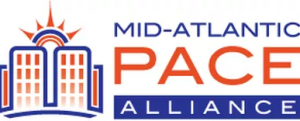 Last week (February 20, 2017) VAEEC participated in the first Mid-Atlantic PACE Alliance (MAPA) kick-off meeting in northern Virginia. MAPA is the result of a U.S. Department of Energy grant to support the development, implementation, and utilization of Commercial Property Assessed Clean Energy (C-PACE) programs throughout Virginia, Maryland, and Washington, D.C. The Virginia Department of Mines, Minerals and Energy is leading this effort between private and public stakeholders to develop and promote best practices, which will make the development of PACE programs more effective and will accelerate the growth of C-PACE programs throughout the region.
Last week (February 20, 2017) VAEEC participated in the first Mid-Atlantic PACE Alliance (MAPA) kick-off meeting in northern Virginia. MAPA is the result of a U.S. Department of Energy grant to support the development, implementation, and utilization of Commercial Property Assessed Clean Energy (C-PACE) programs throughout Virginia, Maryland, and Washington, D.C. The Virginia Department of Mines, Minerals and Energy is leading this effort between private and public stakeholders to develop and promote best practices, which will make the development of PACE programs more effective and will accelerate the growth of C-PACE programs throughout the region.
Educating stakeholders and standardizing templates and models are two key focuses of the MAPA team. Partners will use grant money to educate primary stakeholders (localities, property owners, lenders and borrowers, and contractors) about PACE. The second focus is to develop streamlined, consistent practices that will propel the adoption of PACE across Virginia while supporting the expansion of existing programs in Maryland and Washington, D.C. This includes the creation of consistent, cost-effective practices for program administration, drafting ordinances, financial underwriting guidelines, measurement and verification requirements, contractor training, and overall support.
This grant will enhance the work the VAEEC is already doing to further promote and advance PACE throughout the Commonwealth.
Click here to learn more about MAPA and here to read a copy of Governor McAuliffe’s press release about the grant.
VAEEC Members Encouraged to Apply or Suggest Nominees
February 2017: Virginia’s Board of Housing and Community Development will be filling one seat early this summer. VAEEC would like to see a strong number of diverse nominations representing the energy efficiency industry.
Why is this important to VAEEC?
Members of the governor-appointed Housing and Community Development Board guide and vote upon the content of Virginia’s triennial update of building codes – including the energy efficiency code. Currently Virginia lags behind our neighbors to the north and south for requiring some of the advancements in efficiency standards and testing. Advanced energy codes are among the most cost-effective methods of saving energy, lowering the total cost of housing, improving health and comfort in homes, and improving quality throughout the homebuilding industry. Learn more about the importance of strong energy codes from the U.S. Department of Energy and the Responsible Energy Codes Alliance.
What can you do?
The open seat is in Virginia’s 1st congressional district, and nominees have to reside in the district to be eligible. The 1st district is represented by Rob Whittman and stretches from Williamsburg up through Fredericksburg and Stafford. Not sure if you reside in this district? Check who your legislators are here by entering your address in the yellow circle.
The seat will be filled by July 1, but the administration is expected to identify candidates soon.
Please reach out to me at chelsea@vaeec.org if you’d like to be nominated or can suggest a candidate worthy of support.
Learn more about the Board and the nomination process.
Note from VAEEC Executive Director Chelsea Harnish
Last year was an exciting year for the Virginia Energy Efficiency Council. We are highlighting our successes with our 2016 Annual Report available now for download.
Over the last 12 months, we have:
- Expanded our staff
- Re-branded the organization
- Enhanced our communication with members and regularly sought their feedback
- Launched our campaign to support PACE implementation in localities across the Commonwealth
- Increased our engagement in regulatory processes- including utility regulation at the State Corporation Commission and providing support to members participating in the building codes cycle update
- Solidified our role as the education and outreach partner for the Governor’s Executive Committee on Energy Efficiency
- Launched the very first Virginia Energy Efficiency Leadership Awards Ceremony highlighting the amazing work happening across the Commonwealth in our sector.
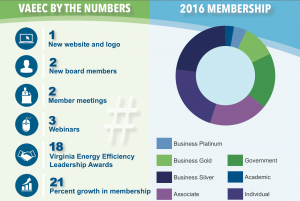 Our members know energy efficiency has tremendous potential to drive economic growth, create jobs, shrink utility bills, conserve natural resources, and reduce pollution. In fact, preliminary numbers from our 2016 Clean Energy Census indicate that building energy efficiency alone accounted for $1.2 billion in annual revenue.
Our members know energy efficiency has tremendous potential to drive economic growth, create jobs, shrink utility bills, conserve natural resources, and reduce pollution. In fact, preliminary numbers from our 2016 Clean Energy Census indicate that building energy efficiency alone accounted for $1.2 billion in annual revenue.
The Virginia Energy Efficiency Council is the voice for the energy efficiency industry in the Commonwealth, which is why our membership increased an astounding 21% over the last year. Our members include Fortune 500 companies, universities, nonprofits, local governments, state agencies, and utilities. The Council’s goal is to ensure energy efficiency is recognized as an integral part of Virginia’s economy and clean energy future.
In 2017, we will build on our successes over the last year and continue to play a pivotal role in advancing energy efficiency in Virginia. Some things we are already doing/ planning:
- Utility Regulation: Intervening in support of Dominion’s energy efficiency programs in their DSM proceedings before the State Corporation Commission this spring and participating in the SCC EM+V protocol proceedings later this year.
- Building Codes: Participating in work group meetings this spring and summer and engaging with board members and staff of state agencies who oversee the building code update cycle.
- PACE: Engaging with local government staff in Arlington County, Richmond (and surrounding counties), Charlottesville, Norfolk, and Roanoke to answer questions on PACE implementation; participating in Richmond’s official PACE stakeholder group and holding events throughout the commonwealth to educate property owners/ managers, financiers and contractors on the benefits of PACE to their work.
- Governor’s Executive Committee on Energy Efficiency: Continue working with our ‘Roadmap Team” to play a supporting role to the GEC’s efforts
- Membership Engagement: Continue to expand our communications with our membership through our annual member survey, e-newsletter and social media accounts, and the launch of our bimonthly webinar series (the next webinar focuses on Industrial Efficiency and is scheduled for 2/28. You can register here.).
- Events: Continue hosting our biannual member meetings with expanded programming and hosting our second inaugural Virginia Energy Efficiency Leadership Awards Ceremony in the fall.
Since 2017 is also an election year here in Virginia — where Virginians will elect a new Governor as well as elect a Lt. Governor and Attorney General — we plan to educate all statewide candidates on the benefits of energy efficiency and introduce them to our work, particularly our partnership with the state energy office. It is important that no matter who our new leaders are, they understand the many benefits that our industry provides to the Commonwealth.
The next 12 months are going to be exciting for the VAEEC and its members and we look forward to our continued work with all of you.
Download our 2016 Annual Report.
“Over the last several years, smart thermostats have opened up new opportunities for residential Demand Response programs, helping to achieve load management goals at reduced cost, while bringing additional benefits such as energy efficiency and improved customer satisfaction. Having worked with a diverse set of energy partners, Nest has been able to glean a much clearer picture of what induces customers to sign up for demand response programs, and what keeps them happy once they’re enrolled.”
That’s an excerpt from a 2016 white paper on the Rush Hour Rewards demand response program offered by VAEEC Gold member – and February 2017 Featured Member of the Month – Nest.
Launched in 2014 to help utilities deal with summer peaks, Nest’s Rush Hour Rewards program runs on the Nest Learning Thermostat. The program centers on running personalized events that maximize load reduction while maintaining customer comfort. Deployed by 18 utilities in North America with more launching this summer, Rush Hour Rewards is available in winter and summer versions.
Some performance highlights:
- An average of 55% aggregate HVAC load reduction during events
- Over half of customers report increased satisfaction with their energy provider after participating
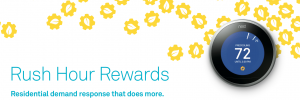 The Rush Hour Rewards white paper breaks down the keys to getting
The Rush Hour Rewards white paper breaks down the keys to getting
customers in the door and ways to keep them happy. It also provides guidance for utilities in figuring out what DR program model would work
best for them.
To get a copy of the white paper, reach out to Dave Bend (davebend@nestlabs.com) , Nest’s Head of East Coast Energy Partnerships. You can also take a look at their Rush Hour Rewards fact sheet
Getting customers in the door:
- Make customers feel rewarded—up-front incentives paid directly to the customer pack the biggest punch.
- Although rewards are important, just as many people are motivated to sign up for environmental reasons as for rewards. Different customers respond to different messages.
- If you want a customer to participate in DR, help them understand what they are signing up for and why they should care.
Keeping customers satisfied:
- Rewards and comfort matter most, but you can’t forget the impact of a customer’s enrollment experience on overall satisfaction.
- Not all rewards are created equal—simple, annual reward structures outperform other models. And large one-time rewards can backfire when the customer expects the same reward again and discovers that it will not be forthcoming.
- Allowing customers to adjust the temperature during an event if they need to has a minimal impact on overall program performance, and strong upside in terms of customer satisfaction and ongoing program participation year after year.
Lowell Ungar, Senior Policy Advisor with the American Council for an Energy-Efficient Economy, wrote the following blog post on what the future of energy efficiency looks like under the Trump administration.
Barely one week into the new administration, we are far enough into the water to see dim shapes of the future ahead—some look more like sharks, some like rocks. Here’s some of what we see as of now:
Department of Energy programs face an undertow. In his confirmation hearing Secretary-designee Rick Perry was surprisingly supportive of DOE’s research and the national labs (for someone who once called to axe the entire agency). But President Donald Trump ordered a broad hiring freeze as a first step toward reducing the federal workforce. There is also reportedly a proposal to eliminate the whole Energy Efficiency and Renewable Energy Office (among others) in a broad budget outline that may be released in February. We are gearing up to support the efficiency programs when Congress takes up funding bills for the rest of 2017 in April and for 2018 later this year.
Appliance standards may be treading water for now. Although three recent standards could be subject to repeal under the Congressional Review Act, they do not appear to be prime targets, based on several meetings with congressional staff. On the other hand, five standards that were finalized but not officially published (as well as a manufactured housing standard that was under final review) may be caught in a temporary moratorium on regulations issued by Trump’s chief of staff Reince Priebus.
Vehicle standards face submerged reefs. The standard for trucks and buses also could be subject to congressional repeal, but it does not appear to be at the top of the target lists. On the other hand, Trump suggested he will ease regulations on car companies, which could include the fuel economy and tailpipe emissions standards for cars and light trucks. In any case, California will very likely maintain its emission standards, which apply in 12 other states as well.
Clean Power Plan may be dead in the water. The new White House website says Trump is “committed to eliminating…the Climate Action Plan,” and Environmental Protection Agency Administrator-designee Scott Pruitt said he continues to oppose the Clean Power Plan rules on carbon emissions from existing power plants. The next step may depend on an imminent ruling from the DC Court of Appeals. But regardless of the fate of this rule, the critical issues of clean air and public health will remain.
Tax reform and infrastructure are about to dive in. Trump continues to talk about infrastructure investment and cutting taxes as ways to spur economic growth. Congress is interested in tax reform but concerned about increased spending. These issues may be paired, starting with a 2018 budget resolution in late spring but extending into the fall. We have joined with other efficiency supporters to send up proposals for tax reforms and investments that increase efficiency. Still on shore is a farm bill that could foster efficiency in rural areas.
Regulatory reform is making waves. Trump signed an executive order directing that for every new rule, two be repealed, and limiting the combined cost (no mention of benefits) of the new and repealed rules, unless prohibited by law. He also has continued his statements against regulations, including a perhaps hyperbolic intent to “cut regulations by 75%, maybe more.” The House has already passed a few bills to make it more difficult to issue new rules or easier to repeal recent ones, but they do not appear to have the 60 Senate votes needed to overcome a filibuster. We and other efficiency supporters sent a letter cautioning Congress not to lose the benefits of appliance standards.
Federal efficiency policy may indeed be in troubled water, but we will seek to keep vital policies and programs afloat while also working at the state and local levels, which are partly sheltered. Following the example of our founders like Art Rosenfeld, our focus will remain on empirical research and analysis, which we trust will show that energy efficiency remains a crucial support for economic development, job creation, and consumer benefits.
The short 2017 Virginia General Assembly is now in session. The VAEEC has taken the following positions on energy efficiency-related bills up for consideration:
VAEEC supports HB 1465 (Sullivan)/ SB 990 (Dance)– Requires DMME or GEC to continue tracking progress towards 10% energy reduction goal (SB 990 passed out of committee 1/23 and is headed to the Senate floor; HB 1465 will be in the energy subcommittee of Commerce and Labor on 1/31; SB 990 passed out of the Senate on 1/31 and will go to the House; HB 1465 was passed by indefinitely on 1/31; SB 990 passed out of the House on 2/17).
VAEEC supports HB 1712 (Minchew)– ESCO coalition bill; amends language on cooperative procurements related to energy performance contracts (Passed out of subcommittee unanimously week of 1/16; passed out of the General Laws committee unanimously on 1/24; will go to the full House for a vote during the week of 1/23; passed out of the House on 1/31 and will go to the Senate).
VAEEC opposes HB 1658 (Marshall)– Anti-benchmarking bill; prohibits third party access to data without consumer consent. This bill will not change current law since third parties cannot access consumer data without the consumer’s consent. After convening a workshop on benchmarking that included VAEEC, several of our members and board members and other interested parties — such as property managers, legislators and homebuilders — the Department of Mines, Minerals and Energy (DMME) plans to continue those conversations over the course of the year in the hopes of coming to consensus on what a benchmarking program could look like in Virginia. We advocate allowing that process to develop a consensus-based approach to the data access/benchmarking issue instead of preemptively preventing it.
This bill was passed by indefinitely in the subcommittee with a letter to DMME asking them to convene a stakeholder group to discuss the issue of data access.
Stay tuned for updates.
Through the Governor’s Executive Council on Energy Efficiency (GEC), the VAEEC was tasked with leading a working group on consistent messaging to help utility and private providers in the Commonwealth deliver similar messages to consumers regarding energy efficiency benefits and programs.
Numerous energy efficiency resources and programs are currently available, which often leads to consumer confusion. Therefore, the goal was to create recommendations to help develop consistent, actionable messaging stakeholders can use to make the energy efficiency education process more effective and to reduce that confusion.
The working group convened three times to:
- Review message testing results (you can see the Virginia Energy Sense presentation on research here)
- Discuss energy efficiency-focused programs happening throughout Virginia and other states (you can watch the webinar from one of the meetings with a presentation by Brian Blackmon with the Knoxville TN Sustainability Office), and
- Create a list of best practices.
These meetings resulted in the development of six recommendations, which were presented to the GEC.
All six recommendations were carefully crafted with the objective to help consumers become better educated about their energy efficiency options, save money, and improve their health and safety while further advancing energy efficiency throughout the Commonwealth. Creating more effective partnerships among energy efficiency stakeholders and between these stakeholders and other consumer advocacy groups is a resounding theme among the recommendations. While it is vital for energy efficiency stakeholders to better communicate and work with each other, we should also partner with health and safety and low-income assistance groups who tend to already have positive relationships with consumers.
VAEEC worked with the members of this group to finalize all six recommendations and presented them to the Governor’s Executive Committee on Energy Efficiency in 2017.

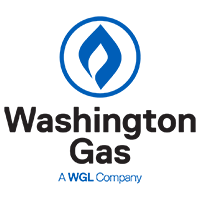

 surrounding region. Washington Gas was founded in 1848, through a Congressional charter signed into law by President James K. Polk. The new company installed gas lights in the House and Senate chambers, the White House and along Pennsylvania Avenue.
surrounding region. Washington Gas was founded in 1848, through a Congressional charter signed into law by President James K. Polk. The new company installed gas lights in the House and Senate chambers, the White House and along Pennsylvania Avenue.

 There are currently 4,400 CHP projects installed nationwide, and the majority are used for industrial applications. Manufacturer, public, and utility benefits of CHP include increased productivity and decreased operating costs. Hood Dairy in Winchester, Virginia, provides a good example. Hood worked with ZF Energy Development to design a 15-MW microgrid, which includes CHP. Not only does this give Hood a reliable, efficient source of power and food security, but it has allowed them to achieve a net savings of at least 25% when compared to grid power and 30% reduced emissions.
There are currently 4,400 CHP projects installed nationwide, and the majority are used for industrial applications. Manufacturer, public, and utility benefits of CHP include increased productivity and decreased operating costs. Hood Dairy in Winchester, Virginia, provides a good example. Hood worked with ZF Energy Development to design a 15-MW microgrid, which includes CHP. Not only does this give Hood a reliable, efficient source of power and food security, but it has allowed them to achieve a net savings of at least 25% when compared to grid power and 30% reduced emissions. Last week (February 20, 2017) VAEEC participated in the first Mid-Atlantic PACE Alliance (MAPA) kick-off meeting in northern Virginia. MAPA is the result of a U.S. Department of Energy grant to support the development, implementation, and utilization of Commercial Property Assessed Clean Energy (C-PACE) programs throughout Virginia, Maryland, and Washington, D.C. The Virginia Department of Mines, Minerals and Energy is leading this effort between private and public stakeholders to develop and promote best practices, which will make the development of PACE programs more effective and will accelerate the growth of C-PACE programs throughout the region.
Last week (February 20, 2017) VAEEC participated in the first Mid-Atlantic PACE Alliance (MAPA) kick-off meeting in northern Virginia. MAPA is the result of a U.S. Department of Energy grant to support the development, implementation, and utilization of Commercial Property Assessed Clean Energy (C-PACE) programs throughout Virginia, Maryland, and Washington, D.C. The Virginia Department of Mines, Minerals and Energy is leading this effort between private and public stakeholders to develop and promote best practices, which will make the development of PACE programs more effective and will accelerate the growth of C-PACE programs throughout the region. 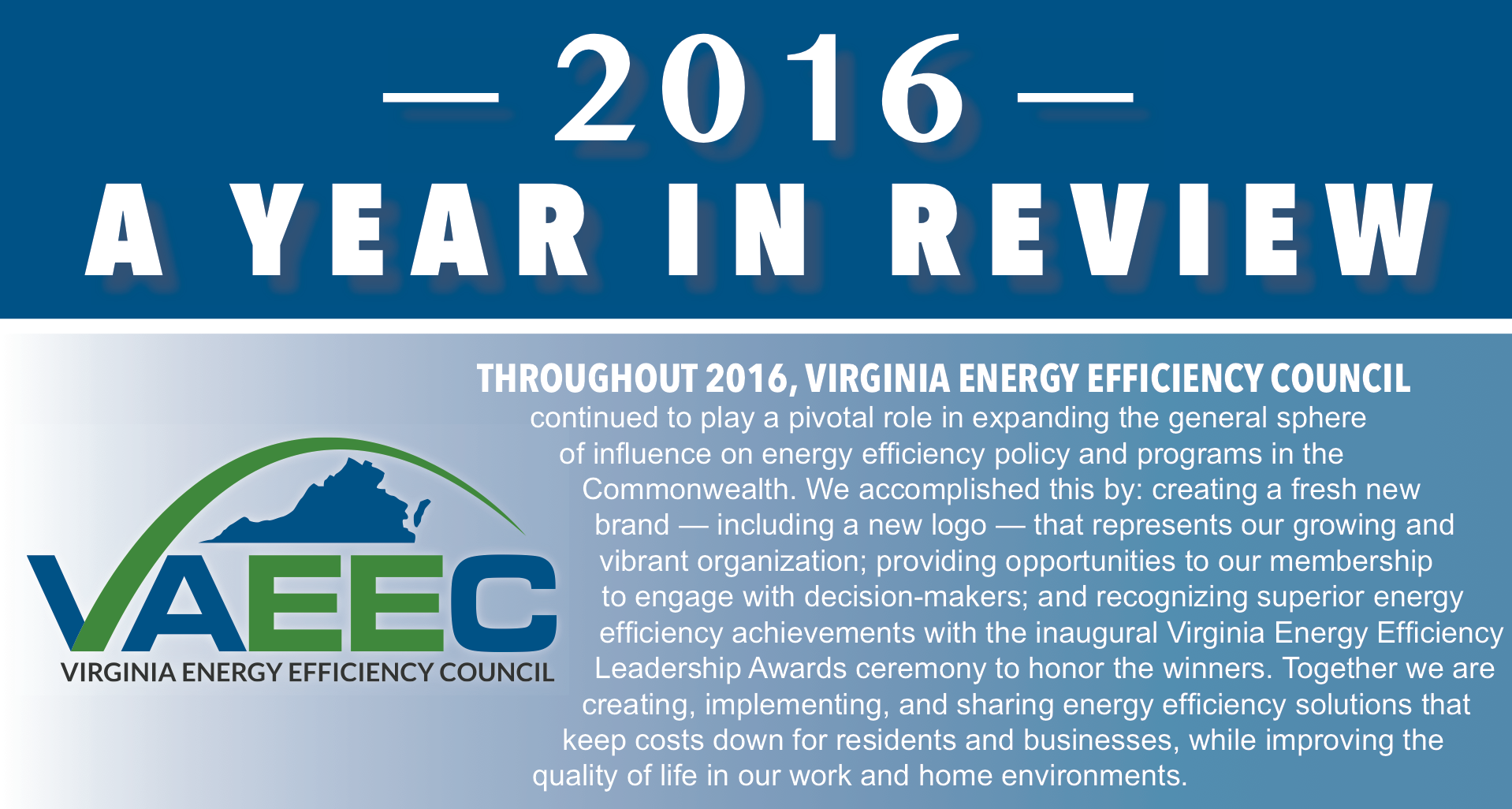

 The Rush Hour Rewards white paper breaks down the keys to getting
The Rush Hour Rewards white paper breaks down the keys to getting